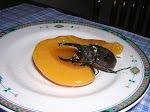 |
| Skipper feeding on Zinnia |
Since being back in the Pacific Northwest, I've been working in school integrated pest management. Not what I thought I'd be doing; my hope was to build on my graduate research with aquatic invertebrates and catapult my career in a new direction -- research in lotic (stream and river) systems with benthic invertebrates. But we entomologists take employment where we can find it, and over the past couple of years, I've been making the most of my current employment opportunity.
Taking the "pest prevention" skills I learned while working in IPM in Arizona and applying it to those critters of my native PNW is a bit surreal, though. This is the land of my childhood, where arthropods were once an intriguing play thing, and only rarely an enemy (e.g., overly attentive deer flies while picking berries with grandma). I still remember the places I went to chase down insects, clumsily with my net, for my college entomology course. I still remember the exact moment of when I made my first kill, tearfully. This is where I fell in love with a love for insects.
By the time I was 25, graduated with a B.S., and traveling the US as a field technician, I was loathe to call anything on six or eight legs a "pest" (except for those deer flies), and held a special disdain for entomologists who did. I was ideal, and wanted to dedicate my career to insect conservation. While some entomologists find this niche and pull it off, most of the jobs are on the dark side (as I thought of it then): pest management. In time, I learned that seeing arthropods as "pests" was the first step in helping people manage them. And by helping people manage them, fewer pesticides are used for the betterment of both the environment and human health. I learned to see the bigger picture and how to compromise -- how to work with and conserve insects through public education and awareness regarding their management.
We entomologists are a schizophrenic bunch in our love for chitinous critters. One moment we're rapt with awe for the little buggars, and the next we are helping you explore the most efficient means of keeping them outside, away from your home, off your crops, and so on. I have worked in the field of integrated pest management for over 8 years. Now I may be among those held in disdain. But I'm still just a kid with a net, a little less clumsy, and a snazzy smart phone with good camera optics in lieu of a kill jar.


























+reduced.jpg)
